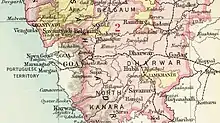Savanur State
Savanur State,[1] Nawab of Savanur was one of the princely states in British India. The last ruler of the state acceded to the Dominion of India on 8 March 1948, becoming part of the Bombay State. Later in 1956, it transferred to Mysore State in what is now Karnataka.
| Savanur State ಸವಣೂರ ಸಂಸ್ಥಾನ | |||||||||
|---|---|---|---|---|---|---|---|---|---|
| Princely State of British India | |||||||||
| 1680–1948 | |||||||||
 Savanur State in the Imperial Gazetteer of India | |||||||||
| Area | |||||||||
• 1901 | 189 km2 (73 sq mi) | ||||||||
| Population | |||||||||
• 1901 | 18,446 | ||||||||
| History | |||||||||
| History | |||||||||
• Established | 1680 | ||||||||
| 1948 | |||||||||
| |||||||||
| Today part of | Karnataka, India | ||||||||
.jpg.webp)
History
The ancestor of the founding dynasty had migrated to India near Delhi in the reign of Timur. 2 centuries later, during the reign of Shah Jahan, Ragati Bahlol Khan migrated from Northern India to the Deccan, where he was granted a Jagir. His grandson, Abul Karim Khan, was prominent in the court politics of Bijapur. The descendant of this family founded the Savanur state.[2]
The name Savanur is said to be the corruption of the Persian word Shahnoor, which means 'king of light'. Few others claim that the city was established in the Hindu month of Shravan, and hence the name Savanur.[3] After the collapse of the Maratha Empire in 1818, following the Third Anglo-Maratha War, Savanur accepted protection from British East India Company and became a British protectorate.[4]
The Nawabs of Savanur were tolerant of all religions and donated liberally to several Hindu temples and mutts. Betel leaves, jowar and cotton were the principal exports of the Savanur state. The Nawabs also had cordial relationship with the Dvaita mutt associated with Sri Satyabodhatirtha.[3]
References
- Imperial Gazetteer of India, v. 22, p. 155.
- Krishnaji Nageshrao Chitnis (2000). The Nawabs of Savanur. ISBN 9788171565214.
- Azer, Rahman (19 August 2014). "Nawabs and paan leaves". No. Bangalore. Deccan Herald. Retrieved 16 January 2015.
- Bombay Gazetteer, Karnataka Dharwad district Chapter III. ed. and publ. by James M. Campbell, 1863, pp. 58–59